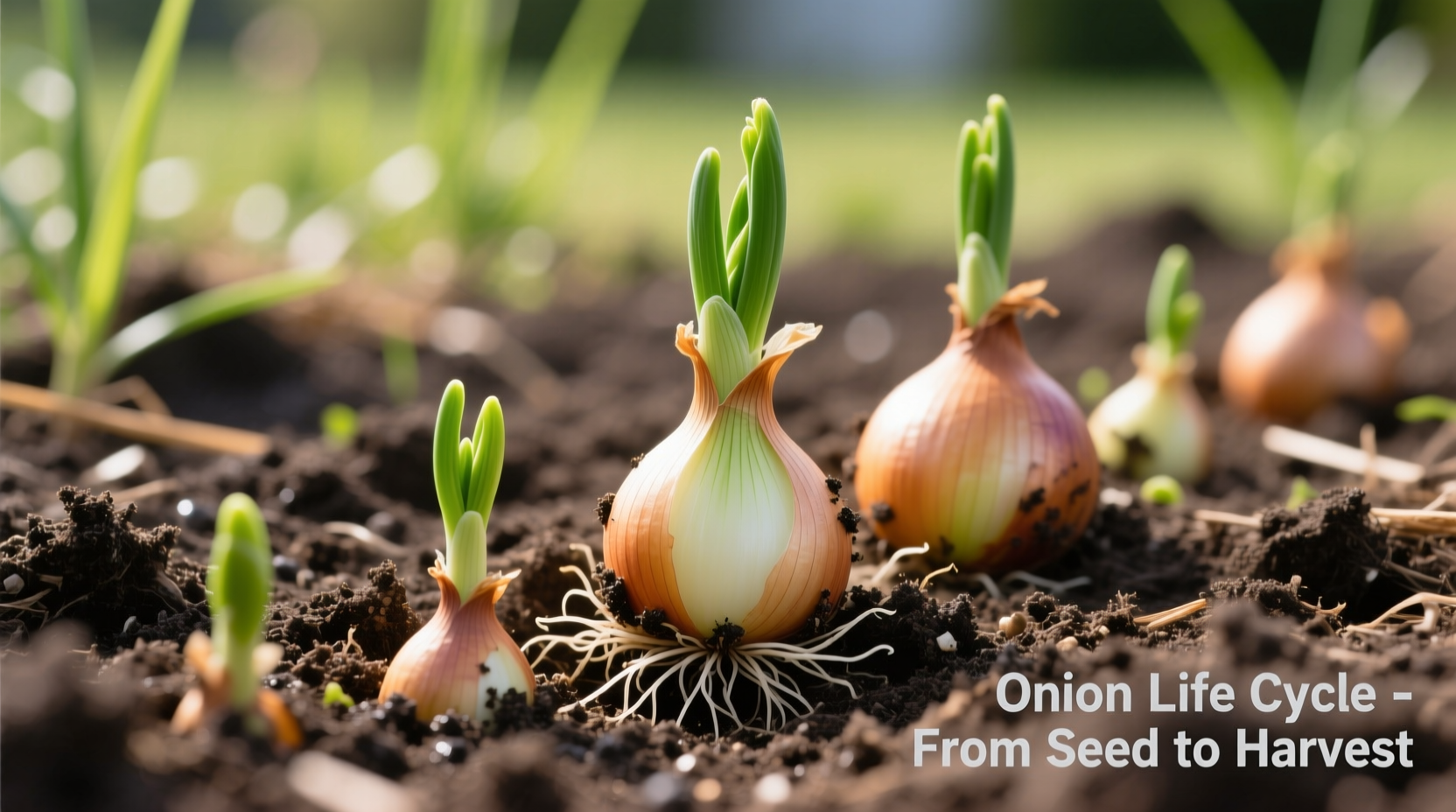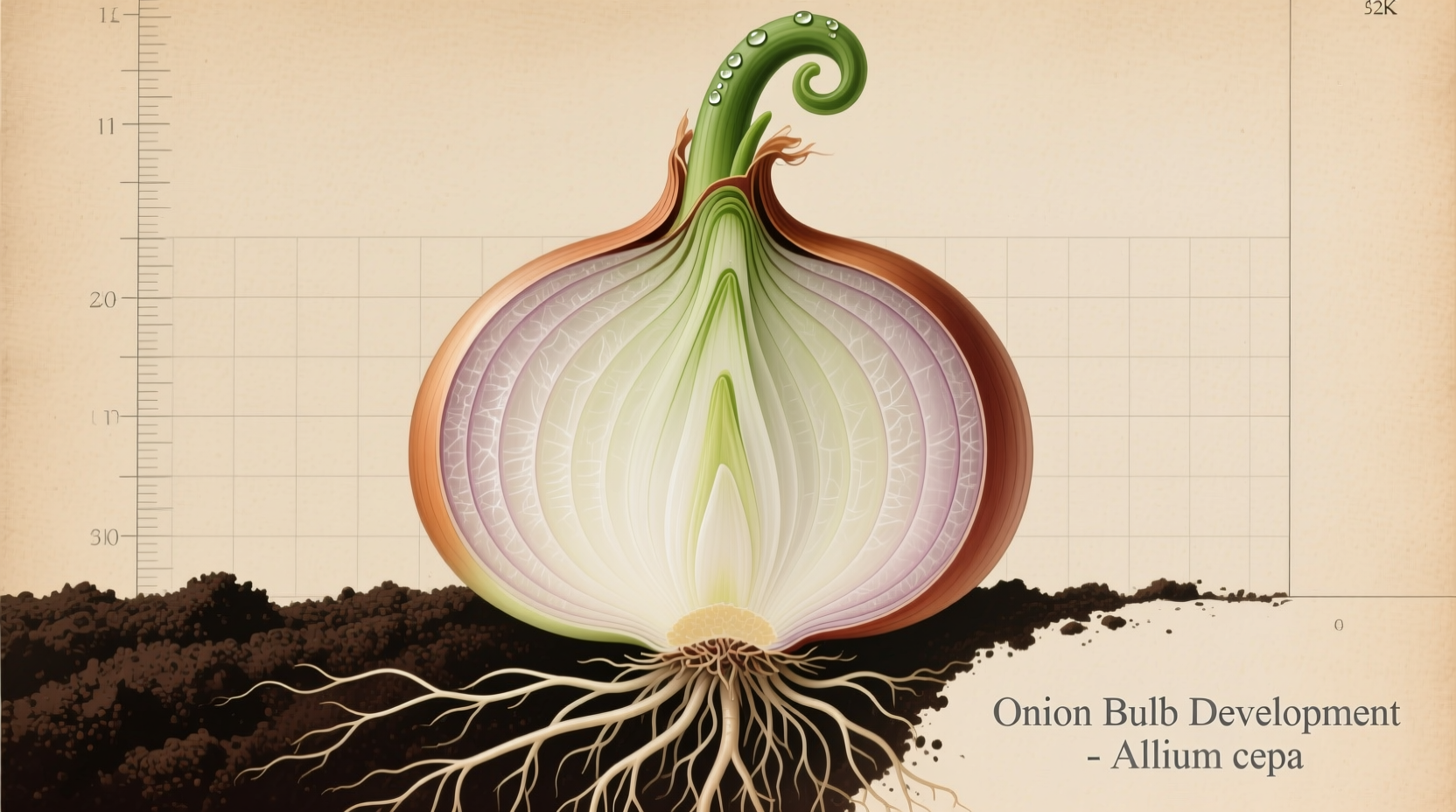Onion bulbs form through a biological process called photoperiodism, where day length triggers the plant to redirect energy from leaf growth to bulb development. Healthy onion bulbs typically reach maturity 90-120 days after planting, depending on variety, with optimal conditions producing firm, well-formed bulbs measuring 2-4 inches in diameter. The critical growth phase occurs when daylight reaches 12-14 hours, signaling the plant to swell its bulb layers using nutrients stored in the leaves.
Understanding onion bulb growth transforms your harvest from disappointing nubs to robust, flavorful bulbs perfect for cooking and storage. Whether you're a beginner gardener or refining your technique, knowing the precise biological triggers and environmental requirements makes all the difference between sparse yields and abundant harvests.
The Biological Process Behind Onion Bulb Formation
Onion bulb development isn't random—it follows a precise biological sequence governed by photoperiodism. Unlike many vegetables, onions respond primarily to day length rather than temperature when initiating bulb formation. When daylight reaches a critical threshold (12-14 hours for most varieties), the plant receives a signal to stop producing new leaves and begin converting stored energy into bulb tissue.
This process involves the plant's meristem tissue transforming from a vegetative state to a storage organ. As the bulb forms, the leaf bases thicken and swell, creating the concentric layers we recognize as an onion. The outer leaves gradually die back, forming the papery skin that protects the bulb during storage.

Onion Growth Timeline: From Seed to Harvest
Successful onion cultivation requires understanding each developmental stage. Here's the complete growth progression you can expect:
| Growth Stage | Duration | Visible Indicators | Critical Actions |
|---|---|---|---|
| Germination | 7-14 days | Green shoots emerge | Maintain consistent moisture |
| Leaf Development | 4-6 weeks | 3-6 true leaves form | Regular watering, nitrogen-rich fertilizer |
| Bulb Initiation | 1-2 weeks | Stem base begins swelling | Reduce nitrogen, increase potassium |
| Bulb Enlargement | 4-8 weeks | Rapid bulb size increase | Consistent watering, monitor for pests |
| Maturity | 2-3 weeks | Top leaves fall over naturally | Reduce watering, prepare for harvest |
Four Critical Factors Determining Bulb Size and Quality
While day length triggers bulb formation, these four factors determine your final harvest quality:
1. Variety Selection for Your Climate Zone
Onions fall into three photoperiod categories that must match your growing region:
- Short-day varieties (10-12 hours): Best for southern regions (Texas, Florida), form bulbs in early spring
- Intermediate-day varieties (12-14 hours): Suitable for mid-latitudes (Virginia, Missouri)
- Long-day varieties (14+ hours): Required for northern regions (Maine, Washington), form bulbs in mid-summer
Planting the wrong variety for your location results in small bulbs or premature bolting. According to the USDA Agricultural Research Service, mismatched varieties account for 68% of poor onion harvests in home gardens.
2. Soil Conditions and Nutrient Management
Onions require specific soil conditions for optimal bulb development:
- pH between 6.0-6.8 for maximum nutrient availability
- Well-draining, loose soil free of rocks and clods
- Consistent moisture (1" per week) without waterlogging
- Nitrogen focus during leaf growth, potassium emphasis during bulb formation
Research from Cornell University's College of Agriculture shows onions grown in compacted soil produce bulbs 30-40% smaller than those in properly prepared beds. The study recommends incorporating 3-4 inches of compost before planting to improve soil structure.
3. Watering Practices During Bulb Formation
Water consistency directly impacts bulb size and storage quality. During the critical bulb enlargement phase (when bulbs reach golf ball size), onions require 1-1.5 inches of water weekly. Inconsistent watering causes:
- Split bulbs from sudden heavy watering after dry periods
- Reduced bulb size from chronic under-watering
- Premature bolting from drought stress
The University of California Cooperative Extension recommends using drip irrigation to maintain consistent soil moisture at 60-70% field capacity during bulb development.
4. Temperature Requirements Throughout Growth
While day length triggers bulb formation, temperature affects growth rate and quality:
- Optimal growing temperature: 55-75°F (13-24°C)
- Bulb initiation occurs most reliably between 68-77°F (20-25°C)
- Temperatures above 85°F (29°C) during bulb formation reduce size and quality
- Frost below 20°F (-7°C) can damage developing bulbs
Troubleshooting Common Onion Bulb Problems
Identify and solve these frequent issues affecting bulb development:
Small Bulb Size: Causes and Solutions
When onions fail to produce substantial bulbs, investigate these potential causes:
- Late planting: Onions need sufficient leaf growth before bulb initiation
- Overcrowding: Space plants 4-6" apart for proper bulb development
- Nitrogen excess during bulb formation: Switch to potassium-rich fertilizer
- Soil compaction: Amend soil with organic matter before planting
- Incorrect variety: Verify your onion type matches your region's day length
Why Onions Bolt (Flower) Prematurely
Bolting diverts energy from bulb formation to seed production, resulting in small, unstoreable onions. Common triggers include:
- Sudden temperature fluctuations (especially cold snaps after warm weather)
- Planting sets that are too large (over ¾" diameter)
- Storing transplants at temperatures below 45°F (7°C) for extended periods
If bolting occurs, remove flower stalks immediately and harvest bulbs promptly—they won't continue growing but can still be used fresh.
Harvesting and Curing Onions for Maximum Storage Life
Proper harvest timing and curing determine whether your onions last weeks or months in storage:
When to Harvest Onions
Watch for these natural indicators that bulbs are mature:
- Top leaves naturally fall over and yellow (about 50% of foliage)
- Neck tissue becomes soft and begins to constrict
- Bulb skins turn dry and papery
For storage onions, wait until at least half the tops have fallen naturally. Harvesting too early produces bulbs with immature skins that won't store well.
Proper Curing Process
After harvest, follow these steps to maximize storage life:
- Cure onions in a warm (75-85°F), dry, well-ventilated area for 2-3 weeks
- Leave roots and tops intact during curing
- Turn bulbs occasionally for even drying
- After curing, trim tops to 1" and roots to ¼"
- Store in mesh bags in a cool (32-45°F), dark, dry location with 65-70% humidity
Properly cured long-day storage varieties can last 6-8 months under ideal conditions, according to research from the USDA Agricultural Research Service.
Advanced Tips for Exceptional Onion Harvests
Implement these professional techniques to maximize your onion bulb quality:
- Plant onions in raised beds to improve drainage and soil warming
- Use black plastic mulch to warm soil and suppress weeds in cooler climates
- Apply potassium sulfate when bulbs begin forming to enhance size and storage quality
- Stop watering 2-3 weeks before harvest to improve skin formation
- Rotate onion planting locations every 3-4 years to prevent disease buildup











 浙公网安备
33010002000092号
浙公网安备
33010002000092号 浙B2-20120091-4
浙B2-20120091-4